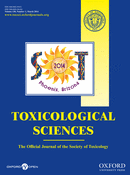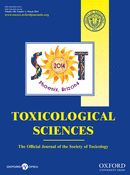
Cover image

Volume 138, Issue 1, March 2014
EDITORIAL
The 53rd Annual Meeting of the Society of Toxicology . . . From Phoenix, Arizona
BIOMARKERS OF TOXICITY
Evaluation of the Relative Performance of 12 Urinary Biomarkers for Renal Safety Across 22 Rat Sensitivity and Specificity Studies
ENDOCRINE TOXICOLOGY
Coexposure to Phytoestrogens and Bisphenol A Mimics Estrogenic Effects in an Additive Manner
ENVIRONMENTAL TOXICOLOGY
Formaldehyde-Associated Changes in microRNAs: Tissue and Temporal Specificity in the Rat Nose, White Blood Cells, and Bone Marrow
Hematopoietic Stem and Progenitor Cell Activation During Chronic Dermatitis Provoked by Constitutively Active Aryl-Hydrocarbon Receptor Driven by Keratin 14 Promoter
IMMUNOTOXICOLOGY
The Analysis of Goldfish (Carassius auratus L.) Innate Immune Responses After Acute and Subchronic Exposures to Oil Sands Process-Affected Water
Membrane-Bound Metallothionein 1 of Murine Dendritic Cells Promotes the Expansion of Regulatory T Cells In Vitro
Influenza Vaccine Response in Adults Exposed to Perfluorooctanoate and Perfluorooctanesulfonate
Editor’s Highlight: Vaccines and their possible adverse effects have received a great deal of popular attention, often based on sketchy science. In this issue of ToxSci, Luster and colleagues provide an example of how quality toxicological research can reveal connections between vaccines, immune function, and environmental exposures. The authors examined a human population that was exposed to perfluorooctanoate (PFOS) and how they responded to vaccines for influenza viruses. The results showed that individuals with high levels of PFOS had weaker antibody responses. Even though an increase in self-reported infections was not observed in this study, the fact that such inadvertent exposures can blunt one of the most important public health interventions demands further attention. Elderly and infirm populations often receive higher doses of vaccines to generate a more robust antibody response. The reported findings suggest that individuals exposed to certain environmental contaminants may also require higher doses of vaccines, or at least titer checks to confirm appropriate vaccine response. –Gary W. Miller


